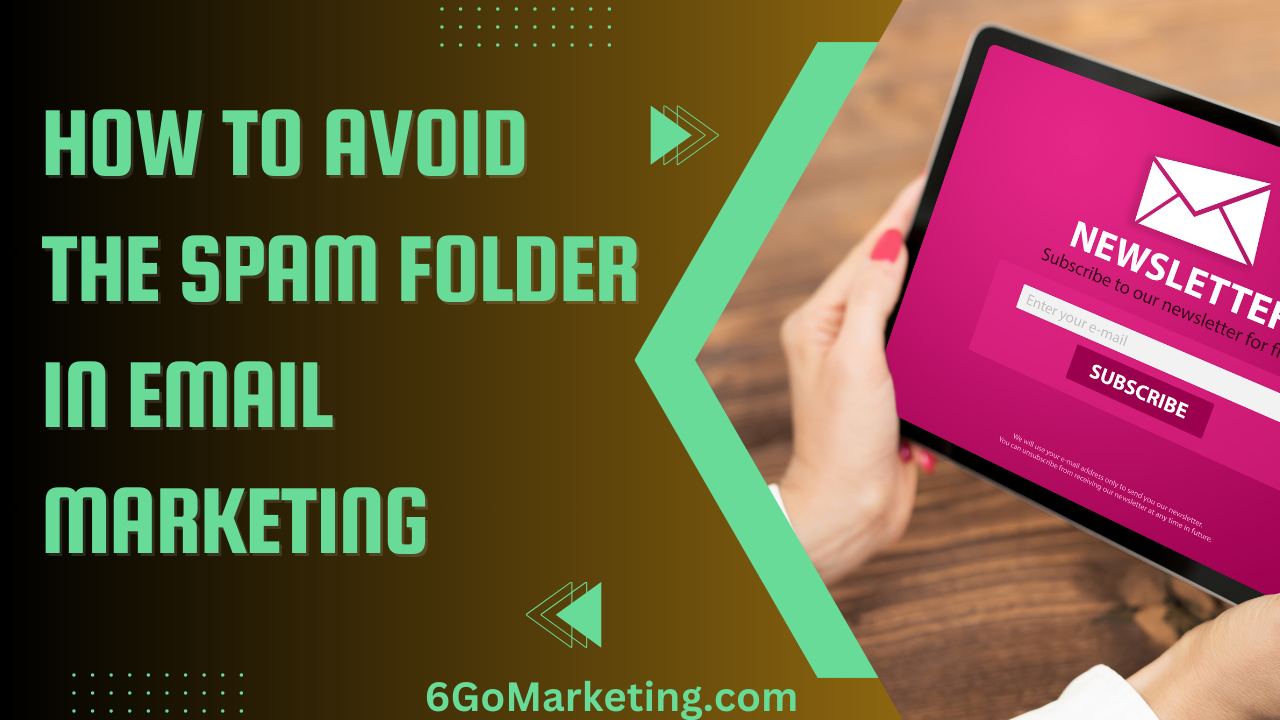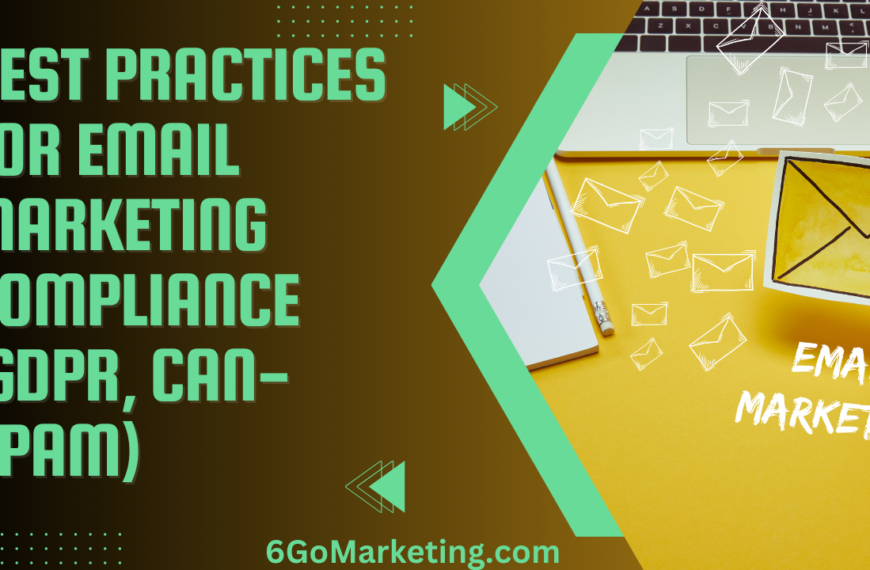Email marketing remains one of the most effective ways to reach your audience, nurture leads, and drive conversions. However, even the best-crafted emails can end up in the spam folder, rendering your efforts useless. Ensuring that your emails land in the inbox rather than the spam folder is crucial for the success of your email marketing campaigns.
In this blog post, we will explore the various strategies you can employ to avoid the spam folder in email marketing. From understanding how spam filters work to following best practices for content and design, we’ll cover everything you need to know to keep your emails in the inbox. Whether you’re a seasoned marketer or just getting started, these tips will help you improve your email deliverability and achieve better results from your campaigns.
Understanding Spam Filters
Before diving into specific strategies, it’s important to understand how spam filters work. Spam filters are algorithms used by email service providers (ESPs) to identify and block unwanted emails. These filters analyze various aspects of an email, including its content, sender reputation, and recipient engagement, to determine whether it should be classified as spam.
How Spam Filters Work
Spam filters use a combination of techniques to assess whether an email is spam. These techniques include:
- Content Analysis: Spam filters analyze the content of an email to detect spammy words, phrases, or formatting. Emails with excessive use of capital letters, multiple exclamation marks, or certain trigger words (like “free,” “buy now,” or “limited time offer”) are more likely to be flagged as spam.
- Sender Reputation: Your sender reputation is a key factor in email deliverability. This reputation is built over time based on your sending practices, including your email bounce rates, spam complaints, and how often your emails are marked as junk.
- Engagement Metrics: Spam filters also consider how recipients interact with your emails. High open rates, click-through rates, and low unsubscribe rates signal that your emails are valuable to your audience, which can improve your deliverability.
- Technical Aspects: Spam filters check the technical configuration of your email, including your domain and IP address, SPF (Sender Policy Framework), DKIM (DomainKeys Identified Mail), and DMARC (Domain-based Message Authentication, Reporting & Conformance) settings. Incorrect or missing configurations can lead to your emails being flagged as spam. Incorrect or missing configurations can lead to your emails being flagged as spam. Setting up DMARC properly can significantly improve email deliverability and help prevent your emails from being flagged as spam. Additionally, using an SPF checker can ensure that your SPF records are correctly configured, verifying that your emails are being sent from authorized servers.
Quote: “Understanding how spam filters work is the first step toward improving your email deliverability. By knowing what triggers these filters, you can take proactive steps to ensure your emails land in the inbox.” — Sarah Johnson, Email Marketing Expert
Example Table: Factors Affecting Spam Filters
| Factor | Description | Impact on Email Deliverability |
|---|---|---|
| Content Analysis | Evaluates email content for spammy words or formatting | High, as it directly affects how the email is perceived |
| Sender Reputation | Based on sending practices like bounce rates and complaints | Significant, as a poor reputation can lead to emails being blocked |
| Engagement Metrics | Measures recipient interaction with emails | High, as better engagement leads to improved deliverability |
| Technical Configuration | Involves domain and IP setup, SPF, DKIM, DMARC | Crucial, as incorrect settings can cause emails to be flagged |
Best Practices to Avoid the Spam Folder
Avoiding the spam folder requires a combination of good sending practices, high-quality content, and technical compliance. Below are some of the best practices that can help you keep your emails in the inbox.
1. Build and Maintain a Quality Email List
One of the most important steps to avoid the spam folder is to ensure that you are sending emails to people who want to receive them. One way to protect your sender reputation is by validating your list with a bulk email checker. A quality email list is made up of subscribers who have opted in to receive your emails, and it should be regularly maintained to remove inactive or invalid addresses. Implementing an embedded email survey can assist in identifying engaged subscribers and maintaining list quality.
How to Build a Quality Email List:
- Use Double Opt-In: Double opt-in requires subscribers to confirm their email address after signing up. This ensures that your list only contains people who are genuinely interested in your content, reducing the likelihood of spam complaints.
- Segment Your List: Segment your email list based on factors like demographics, past purchases, or engagement levels. This allows you to send more targeted emails that are relevant to each group, improving engagement and reducing the risk of being marked as spam.
- Clean Your List Regularly: Regularly remove inactive subscribers or those who have not engaged with your emails for a certain period. Keeping your list clean helps maintain a good sender reputation and reduces bounce rates.
Example Table: Benefits of Building a Quality Email List
| Practice | Description | Benefit to Email Deliverability |
|---|---|---|
| Double Opt-In | Requires email confirmation from subscribers | Ensures list quality, reduces spam complaints |
| Segmentation | Divides the list into targeted groups | Increases relevance, improves engagement |
| List Cleaning | Removes inactive or invalid addresses | Maintains sender reputation, reduces bounce rates |
2. Craft Compelling and Relevant Content
Content is king in email marketing, but it’s also one of the main reasons emails end up in the spam folder. To avoid this, your emails should be relevant, valuable, and well-crafted. Spam filters are likely to flag emails that contain too many spammy words or that lack relevance to the recipient. If you need help creating authentic content, consider hiring a top digital marketing agency to craft stellar email campaigns that engage your audience effectively.
Tips for Crafting Non-Spammy Content:
- Avoid Trigger Words: Words like “free,” “act now,” and “guaranteed” can trigger spam filters. Instead, focus on creating content that is valuable and relevant without relying on these phrases.
- Personalize Your Emails: Personalized emails that address the recipient by name and are tailored to their preferences are more likely to be opened and engaged with. Personalization can improve your sender reputation and reduce the risk of your emails being marked as spam.
- Use a Conversational Tone: Write your emails as if you’re having a conversation with the recipient. A friendly, conversational tone can make your emails feel more personal and less like a sales pitch.
- Include a Clear Call-to-Action (CTA): Ensure that your emails have a clear and compelling CTA that guides the recipient on what to do next. Whether it’s clicking a link, making a purchase, or downloading a resource, the CTA should be easy to understand and follow.
Quote: “Content that resonates with your audience is less likely to be marked as spam. By focusing on relevance and value, you can craft emails that not only get delivered but also drive action.” — John Smith, Content Marketing Strategist
Example Table: Tips for Crafting Non-Spammy Email Content
| Tip | Description | Benefit to Email Performance |
|---|---|---|
| Avoid Trigger Words | Steer clear of words that commonly trigger spam filters | Reduces the likelihood of being flagged as spam |
| Personalize Your Emails | Tailor emails to the recipient’s preferences | Increases open rates, improves engagement |
| Use a Conversational Tone | Write in a friendly, engaging manner | Makes emails feel more personal, less like spam |
| Clear Call-to-Action | Include a simple, compelling CTA | Improves click-through rates, encourages action |
3. Optimize Your Email Design
The design of your email can also impact its deliverability. Poorly designed emails can trigger spam filters or simply fail to engage the reader. By following design best practices, you can create emails that are both visually appealing and compliant with spam filter criteria.
Best Practices for Email Design:
- Balance Text and Images: Avoid relying too heavily on images, as emails with too many images and not enough text can be flagged as spam. A good rule of thumb is to maintain a balanced ratio of text to images.
- Use Alt Text for Images: Always include alt text for images. This not only improves accessibility but also helps spam filters understand the content of your images.
- Keep the Code Clean: Ensure that your email’s HTML code is clean and well-structured. Poorly coded emails can trigger spam filters or display incorrectly on different devices.
- Responsive Design: Design your emails to be responsive, meaning they should look good and function well on all devices, including mobile phones and tablets. With a significant portion of emails being opened on mobile devices, responsive design is crucial for maintaining engagement.
Example Table: Email Design Best Practices
| Design Element | Best Practice | Benefit to Email Deliverability and Engagement |
|---|---|---|
| Balance Text and Images | Maintain a balanced ratio of text to images | Reduces spam risk, improves readability |
| Alt Text for Images | Include descriptive alt text for all images | Enhances accessibility, helps spam filters |
| Clean HTML Code | Use clean, well-structured HTML | Prevents display issues, reduces spam triggers |
| Responsive Design | Ensure emails look good on all devices | Increases mobile engagement, reduces bounce rates |
4. Manage Your Sender Reputation
Your sender reputation is one of the most critical factors in determining whether your emails land in the inbox or the spam folder. A poor sender reputation can result in your emails being blocked entirely, so it’s essential to actively manage and protect your reputation.
How to Maintain a Good Sender Reputation:
- Monitor Spam Complaints: Regularly monitor spam complaints and take steps to address the underlying issues. High spam complaint rates can damage your sender reputation and lead to your emails being blocked. Encourage recipients to mark your emails as important or add you to their contact list to improve your reputation.
- Authenticate Your Domain: Use SPF, DKIM, and DMARC to authenticate your domain. Use SPF, DKIM, and DMARC to authenticate your domain. A reliable DKIM record checker helps ensure your email signatures are correctly set up and functioning. This helps prove to email providers that your emails are legitimate and reduces the likelihood of them being flagged as spam. Authentication is crucial for establishing trust with email service providers.
- Maintain Consistent Sending Practices: Send emails consistently rather than in large, infrequent bursts. Erratic sending patterns can be a red flag to spam filters. Regular, steady email campaigns help maintain a positive reputation and prevent being marked as spam.
- Engage Your Audience: Focus on sending content that your audience finds valuable and engaging. High engagement rates, such as open and click-through rates, signal to email providers that your emails are wanted, which helps boost your sender reputation.
Quote: “Your sender reputation is like a credit score for your email marketing. Keep it high by monitoring your sending practices and consistently delivering value to your audience.” — Emma Thompson, Email Marketing Consultant
Example Table: Key Factors in Maintaining a Good Sender Reputation
| Factor | Description | Impact on Sender Reputation |
|---|---|---|
| Monitor Spam Complaints | Keep track of complaints and address issues | Reduces the risk of being blocked, maintains trust |
| Authenticate Your Domain | Implement SPF, DKIM, and DMARC | Proves legitimacy, reduces the chance of being flagged as spam |
| Consistent Sending Practices | Send emails regularly and steadily | Avoids red flags for spam filters, builds trust |
| Engage Your Audience | Send valuable and relevant content | Increases open rates, improves reputation |
5. Ensure Compliance with Email Marketing Laws
Compliance with email marketing laws is not just about avoiding legal trouble; it’s also key to avoiding the spam folder. Laws like the CAN-SPAM Act in the United States, GDPR in Europe, and CASL in Canada set strict guidelines on how businesses should handle email marketing.
Key Compliance Practices:
- Include a Clear Unsubscribe Option: Always provide an easy and visible way for recipients to unsubscribe from your emails. Failure to include an unsubscribe link is not only illegal but can also lead to your emails being marked as spam.
- Honor Unsubscribe Requests Promptly: When a recipient chooses to unsubscribe, make sure to remove them from your email list immediately. Delays in processing unsubscribe requests can lead to complaints and harm your sender reputation.
- Provide Accurate Sender Information: Ensure that the “From” name and email address accurately reflect your brand. Misleading or false information can lead to spam complaints and legal penalties.
- Respect Privacy and Data Protection: Adhere to data protection laws by obtaining explicit consent before adding someone to your email list, especially if you’re operating in regions governed by GDPR or similar regulations. Always be transparent about how you collect and use subscribers’ data.
Example Table: Compliance Measures in Email Marketing
| Compliance Measure | Description | Benefit to Email Deliverability and Legal Compliance |
|---|---|---|
| Clear Unsubscribe Option | Include an easy-to-find unsubscribe link | Reduces spam complaints, ensures legal compliance |
| Prompt Unsubscribe Processing | Remove unsubscribed recipients immediately | Prevents legal issues, maintains sender reputation |
| Accurate Sender Information | Use a clear “From” name and address | Builds trust, reduces spam complaints |
| Data Protection and Consent | Obtain explicit consent for email subscriptions | Complies with GDPR, builds trust with subscribers |
6. Encourage Positive Engagement
Positive engagement from your recipients—such as opening your emails, clicking on links, and replying—signals to email service providers that your emails are wanted and valuable. Encouraging this type of interaction can help improve your deliverability and reduce the chances of your emails being flagged as spam.
Strategies to Encourage Engagement:
- Craft Compelling Subject Lines: Your subject line is the first thing recipients see, so make it engaging and relevant. A well-crafted subject line can increase open rates and encourage recipients to engage with your content.
- Use Personalization: Personalize your emails by addressing recipients by name and tailoring content to their preferences. Personalized emails are more likely to be opened and acted upon.
- Include Interactive Elements: Adding interactive elements like polls, surveys, or clickable images can encourage recipients to engage with your email. Interactive content makes your emails more dynamic and can increase click-through rates. Image generators can help you create unique, personalized visuals quickly, allowing you to tailor your content to specific campaigns and boost engagement with visually appealing images.
- Ask for Feedback: Invite recipients to reply to your emails with feedback or questions. This not only boosts engagement but also helps you build a stronger relationship with your audience.
Example Table: Engagement Strategies in Email Marketing
| Engagement Strategy | Description | Impact on Email Performance |
|---|---|---|
| Compelling Subject Lines | Write engaging and relevant subject lines | Increases open rates, reduces risk of being ignored |
| Personalization | Tailor emails to the recipient’s preferences | Boosts engagement, improves click-through rates |
| Interactive Elements | Add polls, surveys, or clickable content | Encourages interaction, increases click-through rates |
| Ask for Feedback | Invite recipients to reply with feedback | Builds relationships, increases engagement |
7. Monitor Email Metrics Regularly
To ensure that your email campaigns are performing well and not falling into the spam folder, it’s essential to regularly monitor key email metrics. These metrics can provide insights into how your emails are being received and where there may be areas for improvement.
Key Metrics to Monitor:
- Open Rate: The percentage of recipients who open your email. A low open rate could indicate that your subject lines need improvement or that your emails are landing in the spam folder.
- Click-Through Rate (CTR): The percentage of recipients who click on a link within your email. A low CTR might suggest that your content or CTAs are not resonating with your audience.
- Bounce Rate: The percentage of emails that are not delivered to the recipient’s inbox. A high bounce rate can harm your sender reputation and increase the likelihood of being flagged as spam.
- Spam Complaint Rate: The percentage of recipients who mark your email as spam. Keeping this rate low is crucial for maintaining a good sender reputation and ensuring deliverability.
Quote: “Regularly monitoring your email metrics is essential for identifying potential issues before they escalate. By staying on top of these metrics, you can make data-driven decisions to improve your email marketing strategy.” — James Parker, Email Marketing Analyst
Example Table: Key Email Metrics to Monitor
| Metric | Description | Importance to Email Campaigns |
|---|---|---|
| Open Rate | Percentage of recipients who open your email | Indicates subject line effectiveness, signals deliverability issues |
| Click-Through Rate (CTR) | Percentage of recipients who click on a link | Measures engagement, effectiveness of content |
| Bounce Rate | Percentage of emails not delivered | High rates harm sender reputation, increase spam risk |
| Spam Complaint Rate | Percentage of emails marked as spam | Critical for maintaining sender reputation, reducing risk of being blocked |
Conclusion
Avoiding the spam folder in email marketing is crucial for the success of your campaigns. By understanding how spam filters work, building a quality email list, crafting relevant and compelling content, optimizing your email design, and maintaining a good sender reputation, you can significantly improve your email deliverability.
Additionally, ensuring compliance with email marketing laws, encouraging positive engagement from your recipients, and regularly monitoring key email metrics will help you stay ahead of potential issues and keep your emails in the inbox.
Remember, the key to successful email marketing is not just about sending more emails but sending better emails—ones that are valuable, relevant, and engaging to your audience. By following the strategies outlined in this post, you can build stronger relationships with your subscribers, increase your email marketing ROI, and achieve better results from your campaigns.
Quote: “The best way to avoid the spam folder is to focus on delivering value. When your emails are valuable to your recipients, they’ll engage with them, and you’ll stay out of the spam folder.” — Emily Richards, Digital Marketing Specialist
By implementing these best practices, you’ll be well on your way to mastering email marketing and ensuring that your messages reach their intended audience every time.










